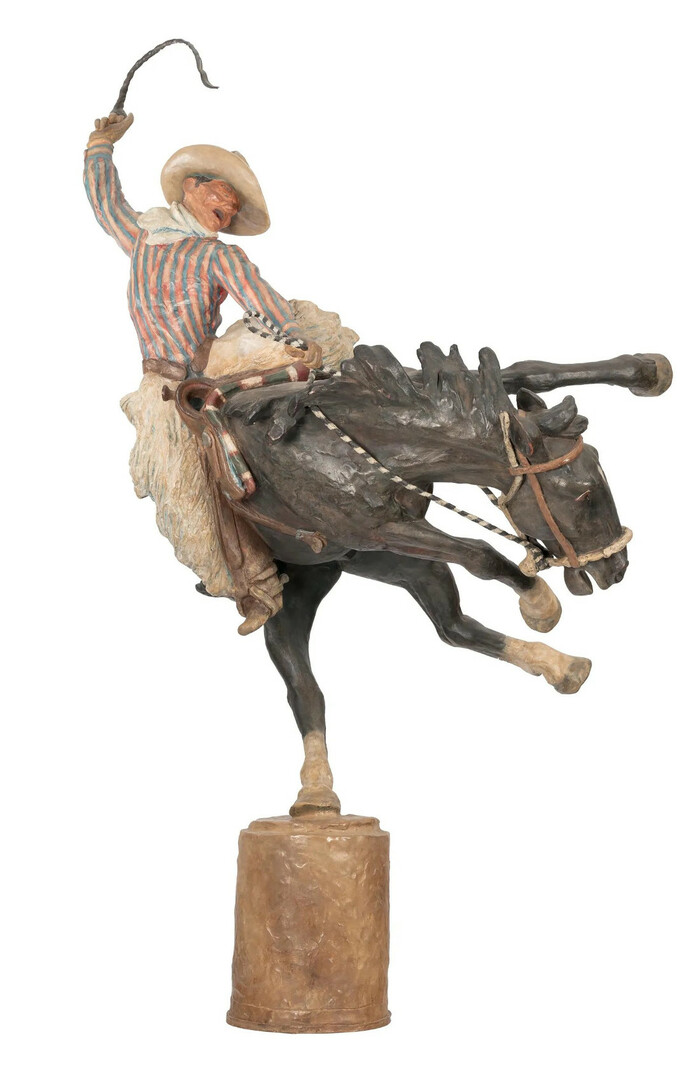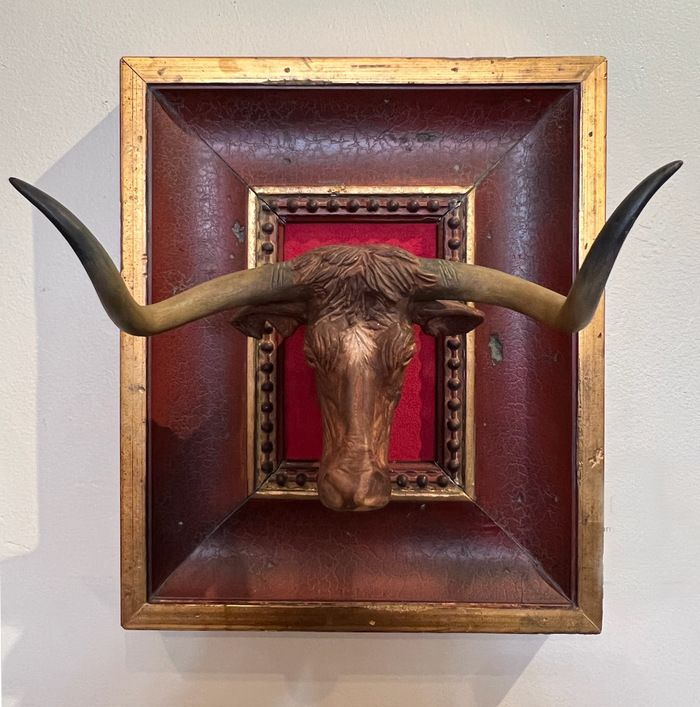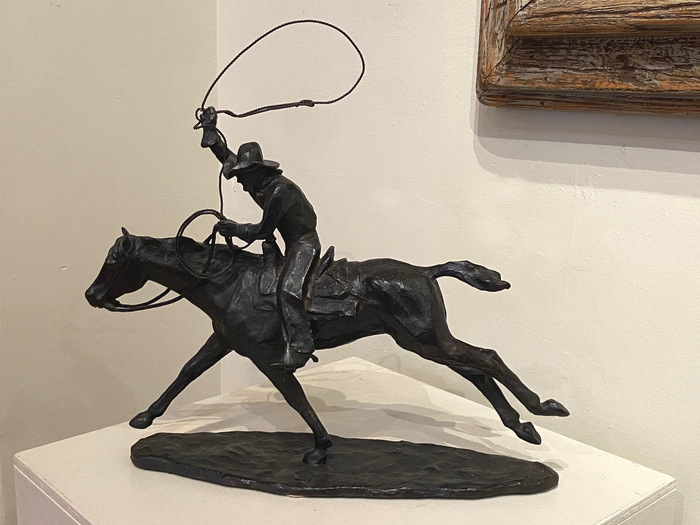Harry Jackson "Cowboy Meditation"
-
- Harry Jackson
- (1924-2011)
- Wyoming / Illinois Artist
- Image Size: 22 x 21 x 10
- Medium: Bronze Sculpture
- Dated 1964 and then dedicated to his friend and fellow artist Bill Dunkin in 1972
- "Cowboy Meditation"
- Contact for Price & Info
- View All By This Artist
Details
Cowboy, Horse, Saddle, Western
-
-
Biography
Harry Jackson (1924-2011)
Harry Andrew Jackson (1924-2011)
Born with the name Harry Shapiro on the South Side of Chicago, Harry Jackson became a well-known 20th-century artists whose wide-ranging work includes painting and sculpture and styles ranging from Abstract Expressionism to Realism.
He was raised in a family where his mother ran a cafe near the Stockyards, and his father was a drunken, violent man. Jackson was often a truant from school and loved to wander around the Harding Museum looking at Frederic Remington bronzes or to hang out at his mother's cafe listening to stories from the cowboys who had brought their cattle by trains to the stockyards. A teacher noticed his art talent and got him a scholarship to the Chicago Art Institute's Saturday children's classes.
At age 14, he ran away from home to Wyoming where he worked at a lumber company and on a ranch. He regarded these experiences as his spiritual awakening, and his art talents were reinforced by praise from his cowboy peers.
In the late 1930s, he returned to Chicago and studied at the Frederick Mizen Academy, The Chicago Academy of Fine Arts, and The Chicago Art Institute. In 1942, he entered the Marine Corps and became close to a man who introduced him to the classics of literature.
In 1943, at Tarawa, he had shrapnel head wounds that caused him epileptic seizures for most of the remainder of his life, and he also took two bullets to the leg at Saipan. He was then, at age 20, ordered back to the U.S. where he was appointed an Official Marine Corps Combat Artist, the youngest in Marine history.
Following discharge, he worked as a radio actor and went to New York with the idea of meeting his hero, Jackson Pollock, whom in 1948 he found to be "a beautiful fantastic man." The two formed a lasting friendship, and Pollock introduced Jackson to Abstract Expressionism, which helped Jackson express his troubled background. Jackson married artist Grace Hartigan, his first of six wives, at Pollock's home with Pollock serving as best man. He also took classes at the Brooklyn Museum and studied with Rufino Tamayo and Hans Hofmann.
The newlyweds went to Mexico and further explored abstraction, and a year later the couple divorced. Jackson did scenery painting for theatre and television, headed to Europe, and returned to New York where he did portrait painting and began to break away from Abstract Expressionism, something that met with disapproval from his peers. He had a Fulbright Travel Scholarship, did some heroic paintings in Denmark, and added sculpting to his repertoire, a medium inspired on March 4, 1958 when he arrived in Peitrasanta, Italy, where a new foundry gave him space. He remained in Italy for several years.
In 1966, his entire output of western art was given the first one-man show at the new National Cowboy Hall of Fame in Oklahoma City. By 1970, he was spending most of his time in Wyoming, becoming a resident of Cody, and was elected to the Cowboy Artists of America, but got "thrown out" because of his refusal to choose allegiances between it and the Cowboy Hall of Fame--entities that had had a major falling out.
Jackson's work is widely held and includes collections of The Vatican, John Wayne, Queen Elizabeth, and the Smithsonian. One of his largest pieces, at the suggestion of the Wayne family, is a six-ton, twenty-one foot high bronze statue of John Wayne for the Great Western Savings Center in Beverly Hills. He is criticized by some persons for applying paint to his sculpture, but he stays to his own course and asserts: "Don't categorize me . . .as a cowboy or Western artist or abstract expressionist artist. I'm an artist".
His studio (2003) was in Cody Wyoming at 602 Blackburn Avenue.
Partial Source:
"Art of the West"
Peggy and Harold Samuels
Added note:
Harry Jackson passed away Monday, April 25, 2011 at the Veterans Hospital in Sheridan, Wyoming. He was a key figure: rambunctious, authentic, and linking New York high society and abstract expressionism with cowboy subjects he knew by the seat of his pants.
Mary Scriver, Valier, Montana
----------------------------------------------------------------------
Harry Jackson was born in Chicago in 1924. As a child his only interests were horses and drawing. At age 14 he ran away to Wyoming where he worked as a ranch hand and was encouraged by the painter Ed Grigware. In 1942, Jackson joined the Marines and was wounded in Pacific service. He later became a combat artist and entertainer.
After the war he studied in New York City with Tamayo and Hans Hoffman. His one-man show in 1952 was of abstract expressionist paintings. By 1956, he was exhibiting as a realist in Italy. In 1957 on fellowships, he began on Western themes leading into Range Burial and Stampede bronzes that were in effect studies for murals. In 1950, he made an album of traditional music, "Harry Jackson, the Cowboy, His Songs, Ballads, and Brag Talk."
Jackson's 1960 New York City show of Western bronzes and drawings was a success. He built a studio and established a foundry on Italy. Best known for his bronzes, he has received substantial attention from national magazines such as Life and Time. In 1972 he wrote "Lost Wax Bronze Casting."
His works are held by major museums such as the Buffalo Bill Museum, Glenbow Foundation (Calgary), Montana Historical Society, Whitney Gallery of Western Art, Wyoming State Gallery, Woolaroc Museum and the Fort Pitt Museum.
Source: Thomas Nygard Gallery
Biography from the Archives of askARTFollowing is the obituary of the artist, The New York Times, April 28, 2011
"Harry Jackson, Artist Who Captured the West, Dies at 87"
By WILLIAM GRIMES
Published: April 28, 2011
Harry Jackson, a Marine combat artist who turned his back on a promising career as an Abstract Expressionist painter to become a prominent realist artist known for his paintings and bronze sculptures of cowboys and Indians, died on Monday in Sheridan, Wyo. He was 87 and lived in Cody, Wyo., and Camaiore, Italy.
His death was confirmed by his son Matthew.
Mr. Jackson, infatuated by the West from early childhood, headed to Wyoming from his hometown, Chicago, at 14 and found work as a ranch hand, working his way up to cowboy. There, when not tending cattle, he turned out shoot-'em-up sketches in the manner of Frederic Remington.
After enlisting in the Marine Corps at 18, he was assigned as a sketch artist to the Fifth Amphibious Corps. He was seriously wounded in the battle for Betio Island in the Tarawa atoll in November 1943 and again at Saipan, for which he was awarded the Purple Heart. Because of his war injuries, he struggled throughout his life with life-threatening epileptic seizures and severe mood disorders.
After being shipped to Los Angeles, he was made an official Marine Corps combat artist, with the assignment to execute drawings and paintings depicting, as he put it, "my bloodiest close-combat experiences." This he did in paintings like Tarawa-Betio (1944), now in the collection of the National Museum of the Marine Corps in Triangle,
After seeing the Jackson Pollock painting The Moon-Woman Cuts the Circle, Mr. Jackson underwent an artistic conversion. The painting, he said, "shot the first crack of daylight into my blocked-off brain." He moved to New York, where he became a close friend of Pollock's and began painting in the Abstract Expressionist style.
He quickly gained notice as an artist to watch when Meyer Schapiro and Clement Greenberg included him in their "Talent 1950" exhibition at the Kootz Gallery, and over the next several years he exhibited at Tibor de Nagy, a nerve center of second-generation Abstract Expressionism.
After traveling to Italy in the early 1950s, he re-embraced realism and undertook a journey in reverse that Life magazine chronicled in an extensive 1956 photo essay, "Painter Striving to Find Himself: Harry Jackson Turns to the Hard Way." One of his first and most ambitious works in the realist mode was The Italian Bar, a large-scale painting, which showed a gathering of regulars in the Mare Chiaro tavern on Mulberry Street in Little Italy.
Returning full circle to the subject matter that had captured his imaginaion as a boy, the West, he produced works such as The Stampede and The Range Burial," sequential paintings depicting a frenzied herd of longhorn cattle dragging a young cowboy off his horse and the somber burial ceremony on the prairie.
He became good friends with John Wayne in the last decade of that actor's life. In 1969, for the cover of Time magazine, he created The Marshal, a sculpture showing Wayne, as Rooster Cogburn in True Grit, on a galloping horse brandishing a rifle in his right hand.
In a review of Mr. Jackson's cowboy art for The New York Times in 1980, Hilton Kramer called his career "unlike any other in the recent history of American art." His change of direction, Mr. Kramer wrote, "has turned a well-known and highly praised but penurious young artist into one of the wealthiest 'unknown' artists in America — an artist unknown, that is, to the art world where his first reputation was made 30 years ago."
Harry Aaron Shapiro Jr. was born on April 18, 1924, in Chicago. After his parents divorced, his mother, whose maiden name was Jackson, renamed him Harry Andrew Jackson. As a child Harry worked at his mother's lunchroom in the Chicago stockyards and developed a fascination with the cowboys he met there. He took Saturday art classes at the Art Institute, and even after moving to Wyoming he returned to Chicago in the winter to resume his art education.
After rejecting Abstract Expressionism, he found his footing as a Western artist when he received a commission in 1958 to create two heroic-size paintings for the Whitney Gallery of Western Art in Cody. The resulting works, each 10 feet by 21 feet, were The Stampede and The Range Burial, which he later executed as bronzes and lithographs.
His other works include "Sacagawea," a large outdoor sculpture at the Buffalo Bill Historical Center in Cody that honors that Shoshone woman who accompanied the Lewis and Clark expedition.
Mr. Jackson's six marriages ended in divorce. In addition to his son Matthew, of Cody, he is survived by two other sons: Jesse, of Miami, and Luke, of Brooklyn; two daughters, Molly Keating of Brownsville, Vt., and Chloë Lear Jackson of Los Angeles; and four grandchildren.Harry Jackson
Sculptor of cowboy figures in bronze that may be painted, born in Chicago in 1924 and living in both Lost Cabin, Wyoming and Camariorre, Italy. "It's just plain jack-ass-ery to say that painting my bronzes makes them look like wood. Hell, nobody complains that painting over canvas detracts from the intrinsic quality of the canvas, but critics still believe I'm defiling bronze when I paint over it.
Brought up near the stables and stockyards, Jackson recalls, "All I was good at was drawing, riding, and running away." At fourteen, he hopped a train for Wyoming and became a cowboy. Encouraged by a local artist, he was soon proficient enough to serve as the youngest official combat artist for the Marines in World War II. After the war, he studied painting with the Abstract Expressionists in New York City. A trip to Italy in 1954 returned him to realistic themes, and in 1956 he was commissioned to paint two heroic scenes of the American West. Among his studies for the paintings were figures in wax. When the patron saw the waxes, he ordered the cast in bronze, and Jackson became a full-time sculptor. His 1960 New York City show helped pay for the studio in Wyoming and the foundry in Italy.
Jackson's bronzes are now in public collection around the world and have been featured in Life and Time, as well as Southwest Art. His commissions include heroic statues of historical subjects and portraits that are not always Western, but he lives on a 40,000-acre ranch where he breeds horses and raises cattle.
Resource: Contemporary Western Artists, by Peggy and Harold Samuels 1982, Judd's Inc., Washington, D.C.







